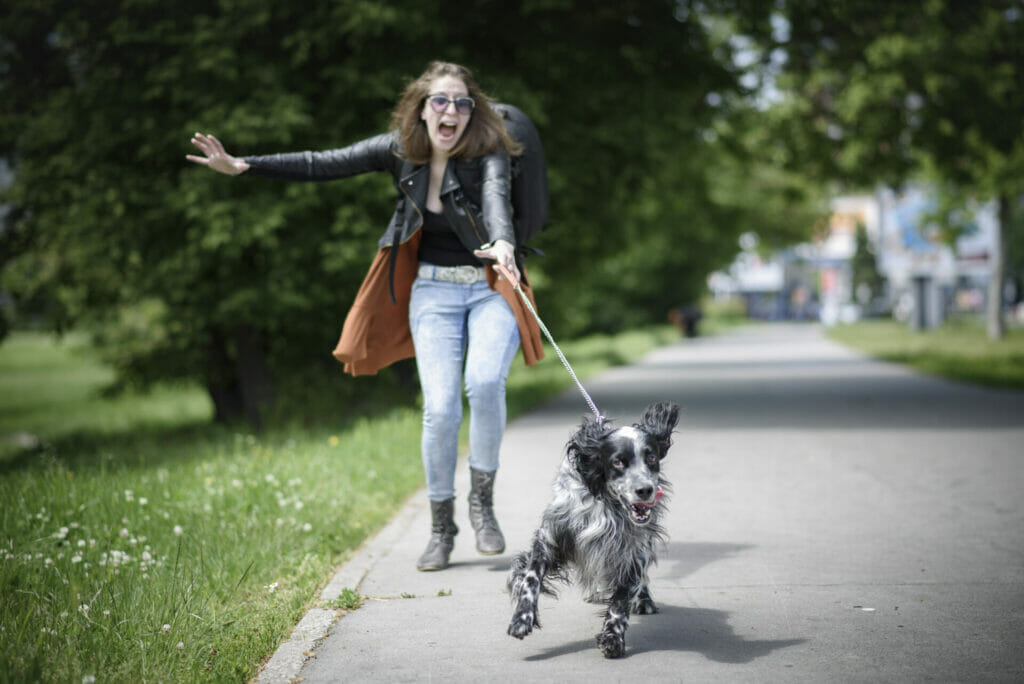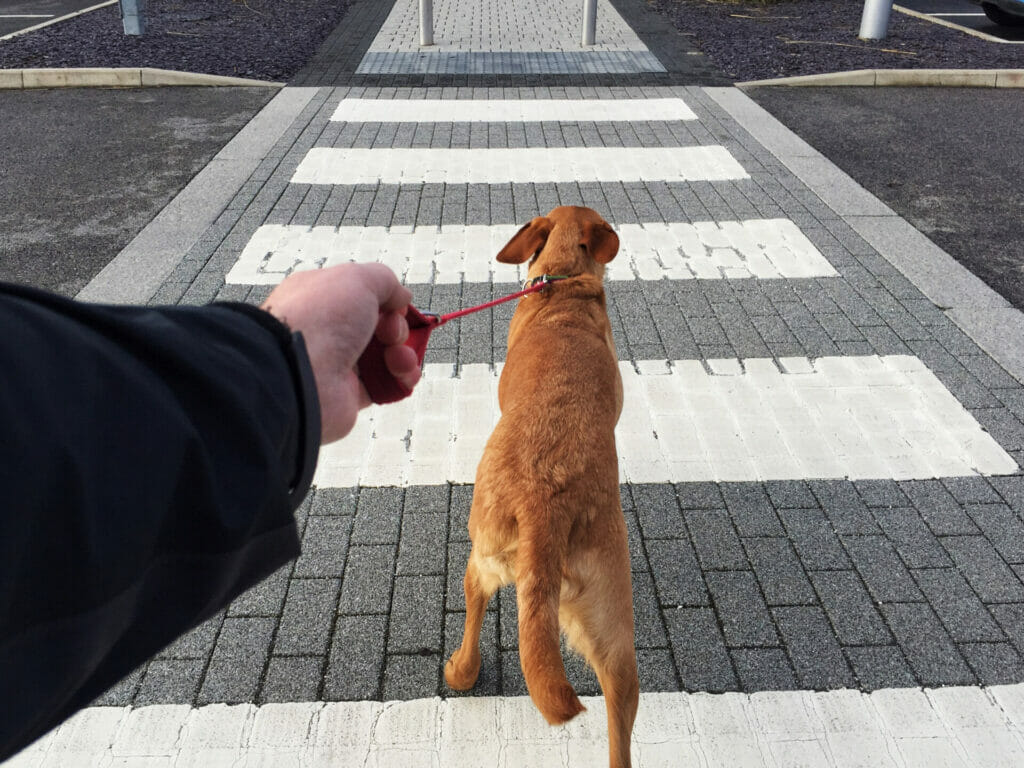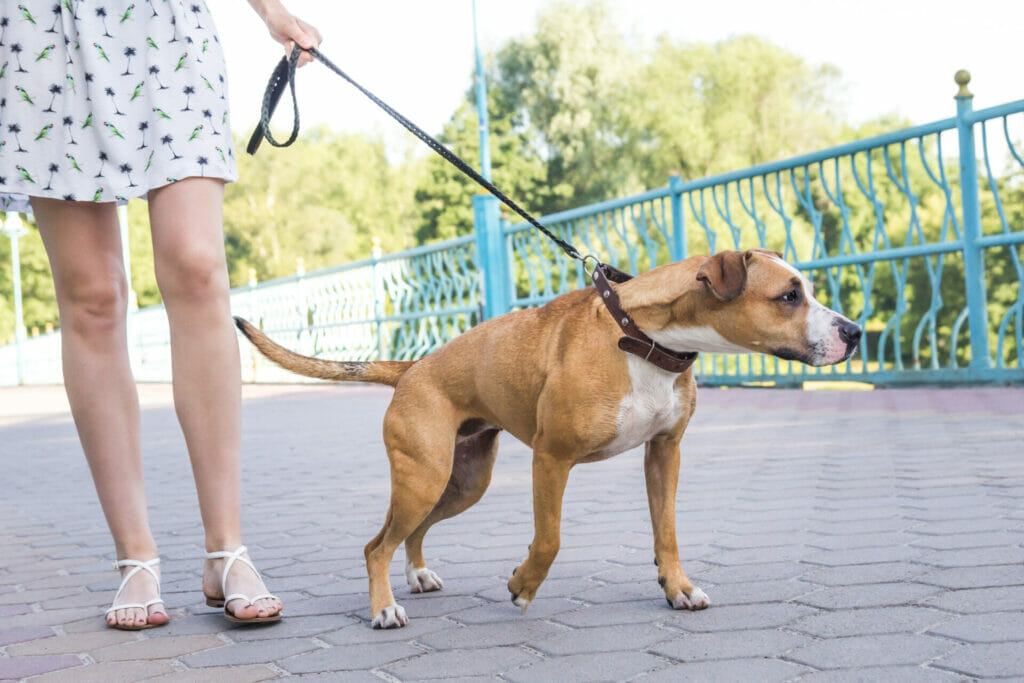Many owners struggle with how to stop leash pulling, and it can feel frustrating when you try to teach your dog to stop pulling, almost like a tug of war. It’s essential to stop leash pulling to enjoy your walks together and prevent yourself from getting hurt by your dog’s pulling.
You can use various tools to help prevent your dog from pulling on the leash, and there are many positive reinforcement training tips we will go over as well to prevent your dog from pulling on their leash in this article.

What equipment can I use to stop leash pulling?
A front clip harness
These harnesses have a leash attachment on the chest that can help to reduce pulling by steering the dog’s body in the desired direction. You can also use a double-ended training leash to keep the dog balanced while walking. This will prevent them from pulling ahead into the harness, which is common when the lead is only attached to the back.
A head collar
If you have a strong or large dog breed, sometimes walking on a leash is impossible. A head collar prevents your dog from pulling, and it will follow you when gently steered.
Properly introducing a headcollar with plenty of treats and positive reinforcement training is essential for your dog to like it and to make walks enjoyable again.
A training leash
A 6-foot training leash with clips on both ends can be wrapped around your waist and attached to your dog. You can then walk your dog hands-free and reward them for walking next to you.
You can also use a training leash for two points of connection on a harness to help prevent pulling and stop your dog from walking ahead.
A treat pouch
This is a must-have tool when training your dog not to pull on the leash. It allows you to have easy access to the treats straight away to reward your dog for not pulling.
Treats
Choose some tasty soft treats your dog likes for training, and don’t be stingy with them! You can even use pieces of your dog’s food and feed throughout the day using their UnKibble.
How to teach a dog not to pull on the leash
Using positive reinforcement training, we can teach a dog not to pull on the leash. By rewarding them for walking next to us, they’ll learn ‘hang out here, and good things happen.’ We call this the reward zone.

Train at home first
Dogs find learning in a low-stress environment easiest, so always start by training indoors. Try this without your dog wearing any equipment at first. As you’re indoors, you won’t need the leash for safety.
- Have your treat pouch loaded up and ready to go
- Lure your dog next to you by popping food on their nose, say good and give them the treats.
- Put another treat on their nose and walk forward a step.
- If they follow, say ‘good’ and give them a treat.
- Keep repeating this and take a couple more steps before you give them the treat.
- Practice this several times and see if you can get up to 20 steps of your dog walking nicely next to you for one treat.
- Now try it with your dog’s leash on in the house, and move on to the backyard or garden if you have one.
Train a dog not to pull outside
Now that you can get your dog to walk nicely next to you indoors, we’ll try it outside. The outside is highly distracting for your dog. There are so many good sniffs to pull towards! When you first get out, let your dog check their pee-mails, and then you can begin training.
- Practice as you did indoors, but wait to ask for too many steps – let’s make it easy for our dogs to get it right.
- Try 2 or 3 steps before you say ‘good’ and give them a treat.
- Keep on as you did before, gradually increasing the number of steps between treats.
- Try walking up and down the same street several times; this will help your dog to focus and avoid being confronted with new exciting smells, dogs, and people.
- Pick up your pace; dogs tend to want to walk faster than us, which is one reason they pull on the leash.
- If you see something or someone you believe will cause your dog to pull, ask your dog to stop and do something else, such as sit or ‘watch me.’ You can also cross the street or change direction.
- Practice this every time you go out; rather than thinking, ‘we’re going for a leash walk,’ think, ‘we’re going to do some training.’
When teaching your dog not to pull on the leash, it is essential to be patient and consistent. It may take some time for your dog to learn not to pull, but with consistent practice, they’ll eventually learn to walk calmly next to you.




















